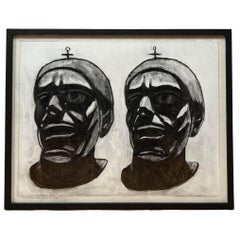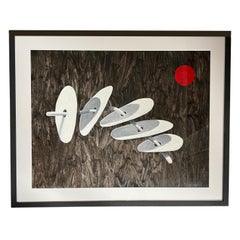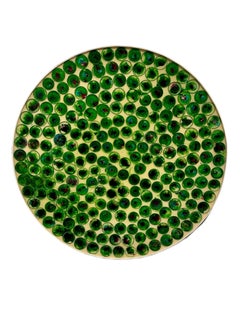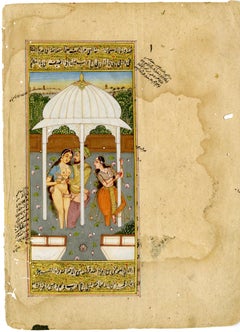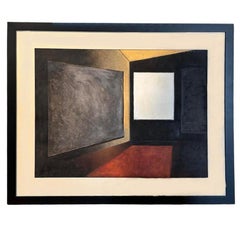Christopher Mark Brennan Art
American, b. 1950
Christopher Mark Brennan is born in 1950. He attended Washington University School of Fine Arts in St Louis, Missouri in 1974. After 1983 he made covers for magazines and artworks for Universal studios, 3 cover Art for Frank Zappa CD, and other musicians.
He now lives in Santa Barbara and makes also smaller but still very striking paintings. His imagination seems to have no limit! He lives a private life, not sharing much online besides his art. I believe it gives us the opportunity to see his artwork with a fresh and unbiased lens.to
5
6
2
Overall Width
to
Overall Height
to
8
3
5
3
3
3
3
2
1
1
1
6
3
3
2
2
8
8,227
2,805
1,656
1,313
8
8
Artist: Christopher Mark Brennan
"Mesmerizing Twins" Black and White Drawing by Christopher Mark Brennan
By Christopher Mark Brennan
Located in Pasadena, CA
The representation of twins in art has always been fascinating due to their embodiment of the concept of duality and symmetry. They often evoke themes of identity, mirroring, and parallel existence. This oil painting on thick paper by Christopher Mark Brennan...
Category
21st Century and Contemporary Post-Modern Christopher Mark Brennan Art
Materials
Oil
"Lined Circles" Geometric Abstract by Christopher Mark Brennan
By Christopher Mark Brennan
Located in Pasadena, CA
Set against a dark, textured black background, this artwork explores the interplay between order and disruption through geometric abstraction. Five white circles, thick and dimension...
Category
2010s Abstract Geometric Christopher Mark Brennan Art
Materials
Acrylic
"Round Squares" Red, Black and White Geometric Abstract by C. Mark Brennan
By Christopher Mark Brennan
Located in Pasadena, CA
Against a black background, textured like slate, white and gray shapes rise, layered atop one another. In the upper section, a white rectangle casts a shadow that intersects a first ...
Category
2010s Abstract Geometric Christopher Mark Brennan Art
Materials
Acrylic
Christopher Mark Brennan Mixed-Media of a Spider
By Christopher Mark Brennan
Located in Pasadena, CA
Brennan never ceases to amaze us, as once again showcased in this mixed-media composition. It features an assemblage of geometric shapes - deep hues of red and yellow accentuated by ...
Category
2010s Christopher Mark Brennan Art
Materials
Ink, Gouache
$600 Sale Price
36% Off
Black and White Drawing of a Clown by Christopher Mark Brennan
By Christopher Mark Brennan
Located in Pasadena, CA
A remarkable piece by Brennan. Clean and thick lines made with ink and gouache, featuring a clown-like figure very different from the usual clowns existing for the kid's fun. The background complements the clown's attire.
Christopher Mark Brennan...
Category
21st Century and Contemporary Other Art Style Christopher Mark Brennan Art
Materials
Wood, Paper, Ink
Mixed-Media Red Hair Portrait by Christopher Mark Brennan
By Christopher Mark Brennan
Located in Pasadena, CA
The artist used very thick oil paint strokes to feature the blazing red hair of a girl and drew her face finely with a crayon.
The contrast between the 2 media is striking!
Christopher Mark Brennan...
Category
21st Century and Contemporary Outsider Art Christopher Mark Brennan Art
Materials
Crayon, Oil
$520 Sale Price
56% Off
Black & White Abstract Three Dimensional Geometric by Christopher Mark Brennan
By Christopher Mark Brennan
Located in Pasadena, CA
This is a remarkable 3D geometric piece by Christopher Mark Brennan. This oil artwork features tubular and semi-circle shapes on a black space...
Category
21st Century and Contemporary Abstract Geometric Christopher Mark Brennan Art
Materials
Canvas, Oil
Woman Drawing by Christopher Mark Brennan
By Christopher Mark Brennan
Located in Pasadena, CA
Another clean line drawing by Brennan, done with sharpie, or marker.
The lines created are bold and precise.
A remarkable piece by Brennan. Clean and thick lines made with ink, featuring a clown-like figure very different from the usual clowns existing for the kid's fun. The background contrasts the clown's attire.
Christopher Mark Brennan...
Category
21st Century and Contemporary Other Art Style Christopher Mark Brennan Art
Materials
Wood, Paper, Ink
$380 Sale Price
60% Off
Related Items
Islands
Located in Faridabad, IN
Designed by Mahesh sharma
Year: 2022
Material: Metal, Resin, acrylic color, Indian bangles
Artist uses mix of techniques to create a beautiful piece of art with blend of Indian handc...
Category
2010s Abstract Geometric Christopher Mark Brennan Art
Materials
Metal
Mughal School, 18th century – Emperor Jahangir in his harem in flagrante delicto
Located in Middletown, NY
Emperor Jahangir in his harem surrounded by lotus blossoms; symbols of paradise itself.
Circa 1690. Gouache and ink with gold heightening on cream laid paper, 8 1/2 x 6 1/4 inches (...
Category
17th Century Rajput Christopher Mark Brennan Art
Materials
Gold
$800
H 8.27 in W 6.3 in
Mughal School, 17th century – Emperor Jahangir reclining in his harem
Located in Middletown, NY
An illuminated page from a book likely in reference to palace life during Emperor Jahangir's reign over the Mughal Empire.
Circa 1690. Gouache and ink with gold heightening on light...
Category
18th Century Rajput Christopher Mark Brennan Art
Materials
Gold
$1,000
H 10.79 in W 5.4 in
St. John the Baptist in the wilderness , Ecce Agnus Dei (Behold the Lamb of God)
By Giovanni Francesco Barbieri (Il Guercino)
Located in Middletown, NY
Pen and sepia ink and wash on vellum, 8 7/8 x 10 1/2 inches (225 x 267 mm). In very good condition with some modern notations in pencil on the verso, minor cockling, and a 1-inch hor...
Category
Mid-17th Century Old Masters Christopher Mark Brennan Art
Materials
Ink, Watercolor, Vellum, Pencil
$650
H 8.88 in W 10.5 in
Israeli Judaica Original Painting, "Temptation" Dancing Polish Artist Arie Dubi
Located in Surfside, FL
Dubi Arie (born Poland, 1939)
"The Temptation"
Image: 11 3/4" x 10"
Original mixed media on paper painting,
Hand signed and dated lower right and signed and titled on reverse. depi...
Category
20th Century Post-Modern Christopher Mark Brennan Art
Materials
Paper, Oil Crayon, Mixed Media, Watercolor
$590
H 10 in W 11.75 in
Israeli Judaica Original Painting King David and Angel Polish Artist Arie Dubi
Located in Surfside, FL
Dubi Arie (born Poland, 1939)
"A Song in the Garden"
Original mixed media on paper painting,
Hand signed and dated lower left.
This piece depicts people dancing, including a King ...
Category
20th Century Post-Modern Christopher Mark Brennan Art
Materials
Paper, Oil Crayon, Mixed Media, Watercolor
Mughal School, 18th century Emperor Jahangir taking tea in his harem
Located in Middletown, NY
An illuminated page from a book likely in reference to palace life during Emperor Jahangir's reign over the Mughal Empire.
circa 1750. Gouache and ink with heightening in gold on li...
Category
18th Century Rajput Christopher Mark Brennan Art
Materials
Gold
Ex Libris 1982, paper, ink, gouache, 17.5х13 cm
Located in Riga, LV
Ex Libris
1982, paper, ink, gouache, 17,5х13 cm
Information about artist:
Gunārs Vīndedzis (1918 - 1991) - cartoonist, illustrator.
Born in a fami...
Category
1980s Realist Christopher Mark Brennan Art
Materials
Paper, Ink, Gouache
$286 Sale Price
20% Off
H 6.89 in W 5.12 in D 0.08 in
Nur Jahan seated with a painted spice jar. Rajasthani School, 19th cent.
Located in Middletown, NY
Ink and gouache with gold heightening on fibrous, brown laid paper with a Jaipur Court Fee tax stamp in purple ink, 13 3/8 x 8 3/4 inches (340 x 222 mm). Toning, handling creases and...
Category
19th Century Rajput Christopher Mark Brennan Art
Materials
Gold
$1,200
H 13.38 in W 8.75 in
"#70 – I AM TIRED", ink, pencil, gouache, collage, vintage, hemingway, poetry
By Amy Williams
Located in Toronto, Ontario
"#70 – I AM TIRED" is from Amy Williams' series "A Farewell to Arms" – wherein the artist works directly onto page 70 of a found copy of Ernest Hemingway'...
Category
21st Century and Contemporary Contemporary Christopher Mark Brennan Art
Materials
Paper, Found Objects, Ink, Gouache, Pencil
Original French Art Deco Gouache Illustration Drawing by J. Hilly
Located in Atlanta, GA
An original Art Deco illustration hand-painted with ink and gouache on paper. The drawing features two elegant women with large windows and drapery in the background. This image was ...
Category
1930s Art Deco Christopher Mark Brennan Art
Materials
Paper, Ink, Gouache
$500
H 15.57 in W 12 in D 2 in
Mythological combat scene with Roman soldiers on horseback.
By Virgil Solis
Located in Middletown, NY
Pen and brownish black ink on grayish-cream laid paper, 6 1/2 x 8 inches (165 x 175 mm), irregular hexagonal sheet with margins. Some archival repairs along the top sheet edge, scatt...
Category
16th Century Old Masters Christopher Mark Brennan Art
Materials
Ink, Laid Paper, Pen
Previously Available Items
"Eye Out" Expressionist Abstract Orange Gouache by Christopher Mark Brennan
By Christopher Mark Brennan
Located in Pasadena, CA
Christopher Brennan’s 2019 painting, Eye Out, presents a dynamic interaction of shapes and tones, typical of an abstract expressionist approach. The composition is dominated by an an...
Category
21st Century and Contemporary Abstract Expressionist Christopher Mark Brennan Art
Materials
Gouache
H 32.5 in W 26.5 in D 0.75 in
Walls #2 Acrylic by Christopher Mark Brennan
By Christopher Mark Brennan
Located in Pasadena, CA
Modernity in art is often synonymous with rupture, challenging traditional forms, and experimenting. Christopher Mark Brennan is a researcher; his studio is a laboratory, so much so ...
Category
21st Century and Contemporary Contemporary Christopher Mark Brennan Art
Materials
Acrylic
H 27.25 in W 33.25 in D 1 in
Walls #1 Acrylic by Christopher Mark Brennan
By Christopher Mark Brennan
Located in Pasadena, CA
Modernity in art is often synonymous with rupture, challenging traditional forms, and experimenting. Christopher Mark Brennan is a researcher; his studio is a laboratory, so much so ...
Category
21st Century and Contemporary Contemporary Christopher Mark Brennan Art
Materials
Acrylic
H 27.25 in W 33.25 in D 0.75 in
"The Gardener" Drawing Christopher by Mark Brennan
By Christopher Mark Brennan
Located in Pasadena, CA
With this black and white drawing, artist Christopher Mark Brennan plunges us into deep meditation on our relationship with nature, highlighting the challenges and contradictions of ...
Category
21st Century and Contemporary Conceptual Christopher Mark Brennan Art
Materials
Gouache
H 25 in W 18.77 in D 0.75 in
"LIFE and DEATH of a Yellow Popsicle" Acrylic Painting by Mark Brennan
By Christopher Mark Brennan
Located in Pasadena, CA
With "Yellow Popsicle", Brennan creates a visually striking acrylic painting that elevates an everyday object to a new singular level of precision and questioning paying homage to Ph...
Category
21st Century and Contemporary Pop Art Christopher Mark Brennan Art
Materials
Acrylic, Paper
Christopher Mark Brennan"LIFE and DEATH of a Yellow Popsicle" Acrylic Painting by Mark Brennan, 2021
H 32.75 in W 26.75 in D 1 in
"Rocket Launch" Humoristic Ink Drawing by Christopher Mark Brennan
By Christopher Mark Brennan
Located in Pasadena, CA
For regulars of our online gallery, you won't be surprised to see another work by Brennan, Californian artist, very secretive about himself, whose prolific and intensely surprising work we follow again and again.
Today's featured work is a watercolor and black-and-white ink piece entitled "Rocket Launch," which has a landscape layout that ingeniously facilitates storytelling - A highly humorist piece -. signed and dated 2021.
The quality of the drawing, the simplified lines, and the extremely elaborate organization of the elements deliver a reading from left to right and from right to left of a rocket that seems to have taken off. On the left, the main character is a cosmonaut who ultimately did not participate in the “intergalactic trip.” His mouth is represented by a simple hyphen, two wide-open eyes like marbles, and the hilarious double presence of a horseshoe that will not be enough to protect him from his fears and give him enough confidence to board the rocket.
It's astounding with what economy of details Brennan brings to life the cosmonaut's dilemma: “Should I board the rocket or stay on solid ground?” By creating a back-and-forth effect from left to right, Brennan brings the "I'm going, I'm not going" dilemma of the cosmonaut to humorous life, with his helmet glued to his knees.
Brennan pays an amazing tribute to all the great illustrators who have been contributors to major magazines, such as Art Spiegelman for the New Yorker, demonstrating his astonishing ability to activate a whole tragicomic aspect in a single image.
Christopher Mark Brennan...
Category
21st Century and Contemporary Contemporary Christopher Mark Brennan Art
Materials
Watercolor, Ink
H 18.75 in W 25 in D 0.88 in
Christopher Mark Brennan art for sale on 1stDibs.
Find a wide variety of authentic Christopher Mark Brennan art available for sale on 1stDibs. You can also browse by medium to find art by Christopher Mark Brennan in ink, paint, oil paint and more. Much of the original work by this artist or collective was created during the 21st century and contemporary and is mostly associated with the contemporary style. Not every interior allows for large Christopher Mark Brennan art, so small editions measuring 19 inches across are available. Christopher Mark Brennan art prices can differ depending upon medium, time period and other attributes. On 1stDibs, the price for these items starts at $650 and tops out at $1,200, while the average work can sell for $855.
